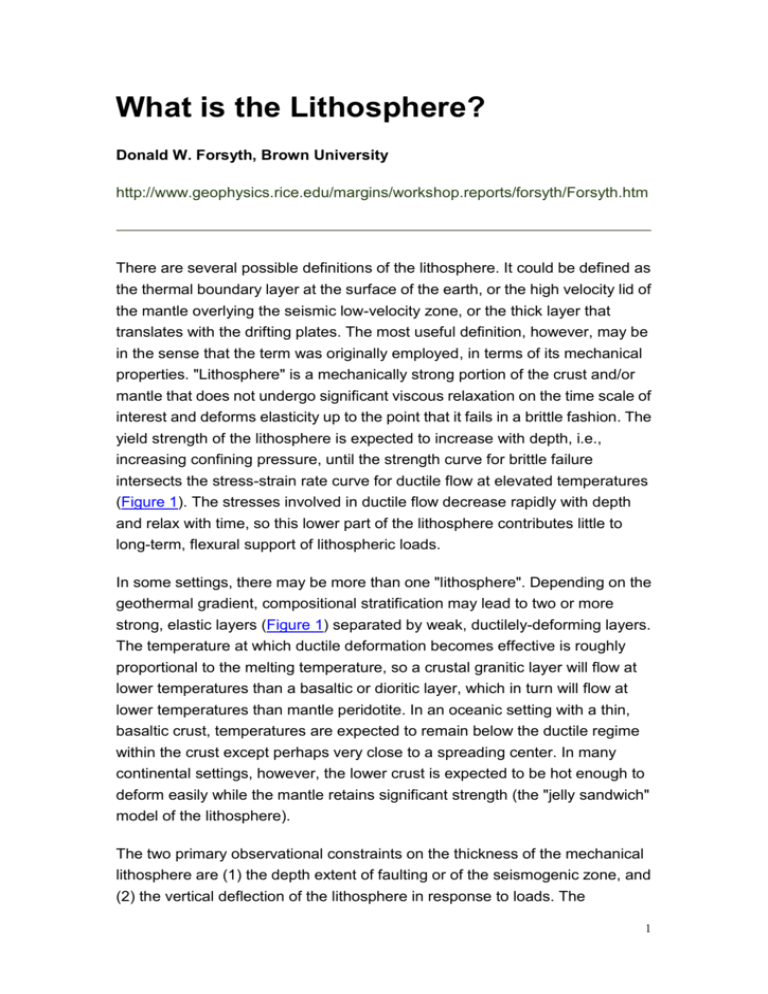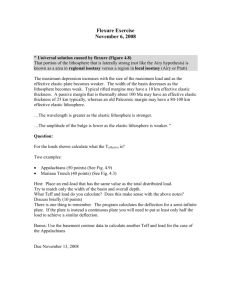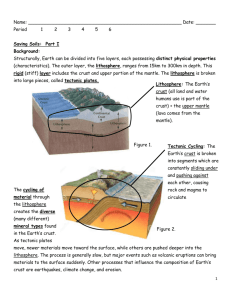What is the Lithosphere
advertisement

What is the Lithosphere? Donald W. Forsyth, Brown University http://www.geophysics.rice.edu/margins/workshop.reports/forsyth/Forsyth.htm There are several possible definitions of the lithosphere. It could be defined as the thermal boundary layer at the surface of the earth, or the high velocity lid of the mantle overlying the seismic low-velocity zone, or the thick layer that translates with the drifting plates. The most useful definition, however, may be in the sense that the term was originally employed, in terms of its mechanical properties. "Lithosphere" is a mechanically strong portion of the crust and/or mantle that does not undergo significant viscous relaxation on the time scale of interest and deforms elasticity up to the point that it fails in a brittle fashion. The yield strength of the lithosphere is expected to increase with depth, i.e., increasing confining pressure, until the strength curve for brittle failure intersects the stress-strain rate curve for ductile flow at elevated temperatures (Figure 1). The stresses involved in ductile flow decrease rapidly with depth and relax with time, so this lower part of the lithosphere contributes little to long-term, flexural support of lithospheric loads. In some settings, there may be more than one "lithosphere". Depending on the geothermal gradient, compositional stratification may lead to two or more strong, elastic layers (Figure 1) separated by weak, ductilely-deforming layers. The temperature at which ductile deformation becomes effective is roughly proportional to the melting temperature, so a crustal granitic layer will flow at lower temperatures than a basaltic or dioritic layer, which in turn will flow at lower temperatures than mantle peridotite. In an oceanic setting with a thin, basaltic crust, temperatures are expected to remain below the ductile regime within the crust except perhaps very close to a spreading center. In many continental settings, however, the lower crust is expected to be hot enough to deform easily while the mantle retains significant strength (the "jelly sandwich" model of the lithosphere). The two primary observational constraints on the thickness of the mechanical lithosphere are (1) the depth extent of faulting or of the seismogenic zone, and (2) the vertical deflection of the lithosphere in response to loads. The 1 mechanical stiffness of the plate is often described by the flexural rigidity, D, which is controlled by the effective elastic thickness of the plate, Te, D = E * [Te^3] / 12 * [1 - (v^2)] where E and n are the elastic coefficients, Young's modulus and Poisson's ratio, respectively. In response to the weight of a topographic or other load, the lithosphere will flex until the deflection of density interfaces and the bending stresses within the plate balance the load. This flexure is described by a characteristic flexural wavelength, lambda, given by lambda = [4*D / g * (delta)p ] ^1/4 where g is the gravitational acceleration and (delta)p is the effective density of the load. Observations of apparent wavelength thus yield estimates of the effective elastic thickness of the lithosphere. One example of characteristic wavelength is the bending of oceanic plates before subduction at trenches. Theory predicts that the deflection will be of the form of a damped, sinusoidal oscillation and most of the observations of topography seaward of trenches are fit very well by a curve of that form (Figure 2). However, we know from the many earthquakes that accompany this bending that the yield stress in parts of the plate must be exceeded. This is expected, because the elastic fiber stresses in a bending plate are directly proportional to the product of the curvature of the plate and the distance from the neutral surface. Thus, as bending proceeds, the uppermost part of the plate should yield in brittle fashion and the lowermost part of the plate will either deform ductilely or yield in earthquakes if the stresses are high enough. Once yielding begins, only the core of the plate remains elastic (Figure 3), so the effective elastic thickness of the plate is reduced and will be less than the true mechanical thickness in most cases involving finite deformation. Estimates of the mechanical thickness of oceanic lithosphere, corrected for the 2 thinning effects of strong curvature, are in excellent agreement with the depth extent of intraplate earthquakes and both appear to coincide with the predicted depth to the 600 to 800°C isotherm (Figure 4 and Figure5), which is approximately the temperature in olivine that creep should become an important mechanism. In the oceans, the primary control on the thickness of the mechanical lithosphere thus appears to be the temperature within the cooling thermal boundary layer. In the continents, the effective elastic thickness has been estimated from the shapes of sedimentary basins, the statistical relationship between topography and the gravity anomalies produced by the compensation of the topography, and the deformation accompanying slip on faults. These diverse types of observations are in rough agreement that the effective elastic thickness of continents ranges from a few km in extensional provinces like the Basin and Range province of the western U.S. to on the order of 100 km in the old interiors of the continents, like the Canadian shield (Figure 6). This pattern of dependence of the rigidity on the age of the province suggest that temperature is also a primary control on the thickness of the lithosphere in continents. In some areas, the lithosphere extends through the entire crust and well into the mantle. In other areas, like the western U.S., the effective elastic thickness is substantially less than the thickness of the crust. The depth extent of earthquakes provides corroborating evidence that the mechanical lithosphere is limited to the crust in some areas. In southern and central California and the Basin and Range province, for example, earthquakes are limited to approximately the upper 15 km of crust. In other areas, earthquakes extend throughout the crust and into the mantle. In the Basin and Range province, the depth extent of earthquakes exceeds the effective elastic thickness, suggesting that yielding or slip on faults is reducing the effective rigidity of the lithosphere. There is little or no direct evidence from flexural studies or earthquake depths for the "jelly sandwich model" of the lithosphere. Flexural studies lack the resolution to distinguish this detail partly because there are trade-offs between deviations from an ideal elastic profile caused by vertical heterogeneities in stiffness and those caused by lateral variations in rigidity or loading. In a few rare instances there seem to be both shallow and deeper earthquakes separated by an aseismic region in the lower crust, but these are primarily associated with areas of subduction where the geothermal gradient may be disturbed by subduction of colder material. There is much geological evidence 3 that the lower crust deforms in many tectonic settings and may act as a decoupling zone, but there is little direct evidence constraining the rheological behavior of the underlying mantle except when subduction is involved. The mantle may be stiffer than the overlying crust, but it could still be in the ductile regime. One possible example of simultaneous faulting in both the upper crust and uppermost mantle with a weak shear zone in between is revealed by seismic reflection profiles around the British Isles that clearly show dipping reflectors within the mantle (Figure 7) that may be normal faults. Although alternative interpretations are possible, this may be the best example of jelly sandwich behavior in an extensional province. There appears to be remarkable congruence between the predictions of rheological behavior based on laboratory, rock-deformation experiments and thermal models, the observations of plate flexure, and the depth extent of earthquakes. There remains, however, one major problem in our understanding of the mechanical behavior of the lithosphere. The experiments predict that slip on faults within the lithosphere requires hundreds of MPa of differential stress (Figure 1). These stress levels are at odds with all our other indicators of the level of stress. Stress drops in earthquakes average a few MPa rather than hundreds of MPa. For low-angle normal faults extending through the seismogenic zone to be active requires very low stress levels on the faults. Heat flow and in situ measurements of stress orientation in the vicinity of the San Andreas fault suggest that the differential stress on the San Andreas fault is less than 20 MPa. Low effective flexural rigidity in regions with many active faults, such as the Basin and Range Province, suggest that the stress levels on the faults must be significantly less than the laboratory estimates of the stress envelopes. Finally, it is unlikely that plate driving stresses generate more than about 100 MPa average stress through the lithosphere in the interior of plates. Thus, although the stress envelope model agrees with the apparent flexural properties of the lithosphere in many cases, the level of stresses predicted for the yielding of the plate exceed the estimates of stresses on major faults by an order of magnitude. There remains a key, unresolved question. What is the level of differential stress required for slip on faults within the lithosphere? References 4 1. Bechtel, TD, DW Forsyth, VL Sharpton, and RAF Grieve. Variations in effective elastic thickness of the North American lithosphere, Nature, 343, 636-638, 1990. 2. Caldwell, JG, WF Haxby, DE Karig, and DL Turcotte. On the applicability of a universal elastic trench profile, Earth Planet. Sci. Lett., 31, 239-246, 1976. 3. Kirby, SH. Rheology of the lithosphere, Rev. Geophys. Space Phys., 21, 1458-1487, 1983. 4. McNutt, MK. Lithospheric flexure and thermal anomalies, J. Geophys. Res., 89, 11180-11194, 1984. 5. Reston, TJ. The lower crust and the extension of the continental lithosphere: Kinematic analysis of BIRPS deep seismic data, Tectonics, 9, 1235-1248, 1990. 6. Wiens, DA and S Stein, Age dependence of oceanic seismicity and implications for lithospheric evolution, J. Geophys. Res., 88, 6455-6468, 1983. Figure 1. Typical yield stress envelopes for lithospheric flexure. Depth to the ductile flow regime depends on composition, geothermal gradient and strain rate. Compositional stratification in the continents will sometimes lead to development of a crustal asthenosphere separating upper crustal and uppermost mantle lithospheres. 5 Figure 2. Topographic profiles seaward of oceanic trenches are fit well by a model of a flexed elastic plate (dashed line). Wavelength of the deformation constrains the mechanical thickness of the lithosphere. (From Caldwell et al., 1976). Figure 3. Stress profile in a bending plate. Without yielding, the stress profile in an elastic plate is expected to be linear with a neutral surface in the center (point c). Bending creates stresses which would exceed the yield strength in the upper lithosphere (line a-b) and induce ductile flow in the lower lithosphere (line d-e), so that only the central core of the plate remains elastic (line b-c-d). (From Kirby, 1983). 6 Figure 4. Estimates of mechanical thickness of the plate based on flexure beneath seamounts (filled symbols) and seaward of trenches (open symbols). Thickness is corrected for effects of yielding and age is corrected for effects of reheating of the lithosphere. Isotherms are for a 125-km-thick cooling plate model. (From McNutt, 1984). 7 Figure 5. Depth of oceanic, intraplate earthquakes as a function of age of the lithosphere. Thermal model is as in figure 4. (From Wiens and Stein, 1983). Figure 6. Variations in effective elastic thickness of the North American lithosphere. Contours are in km. Estimates based on coherence between topography and Bouguer gravity anomaly. (From Bechtel, et. al, 1990). 8 Figure 7. Interpretation of the DRUM seismic reflection profile, from the Outer Isles Fault (OIF) on the western end to the Shetland Platform on the eastern end. Top panel: line drawing of seismic profile. Vertical axis two-way travel-time (TWT in seconds. Middle panel: model interpretation of the reflection profile. If the Shetland Platform is pinned as the reference point, then extension accomplished by normal faulting in the upper crust increases progressively to the west. Extension in the mantle may be accommodated on a single normal fault, the Flannan Fault. Bottom panel: predicted shear of initially vertical markers. If the extension in the mantle layer is equal to the extension in the upper crust, then considerable shear must occur in the seismically reflective, lower crust, which may be acting as a crustal asthenosphere. (From Reston, 1990). 9








